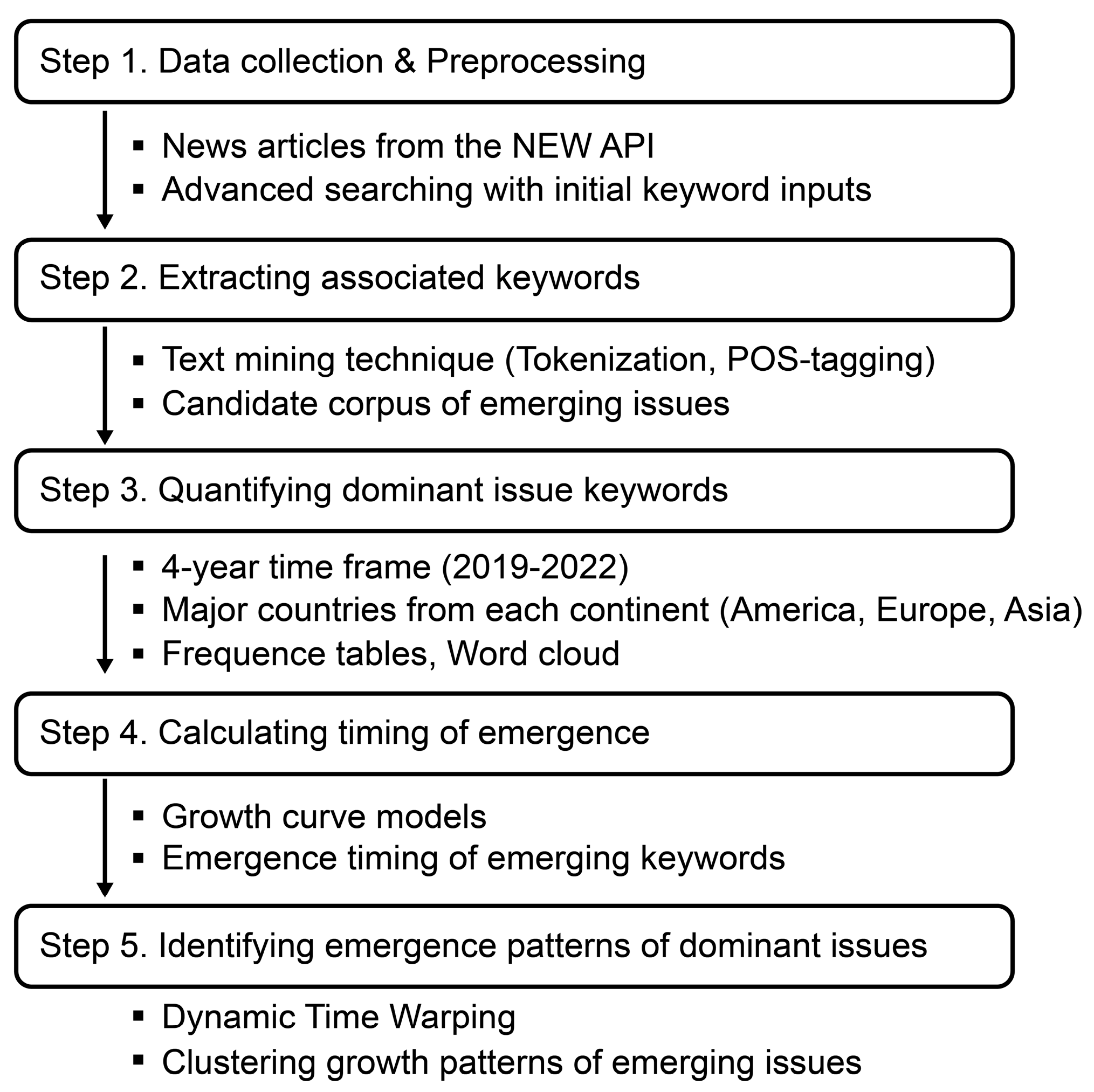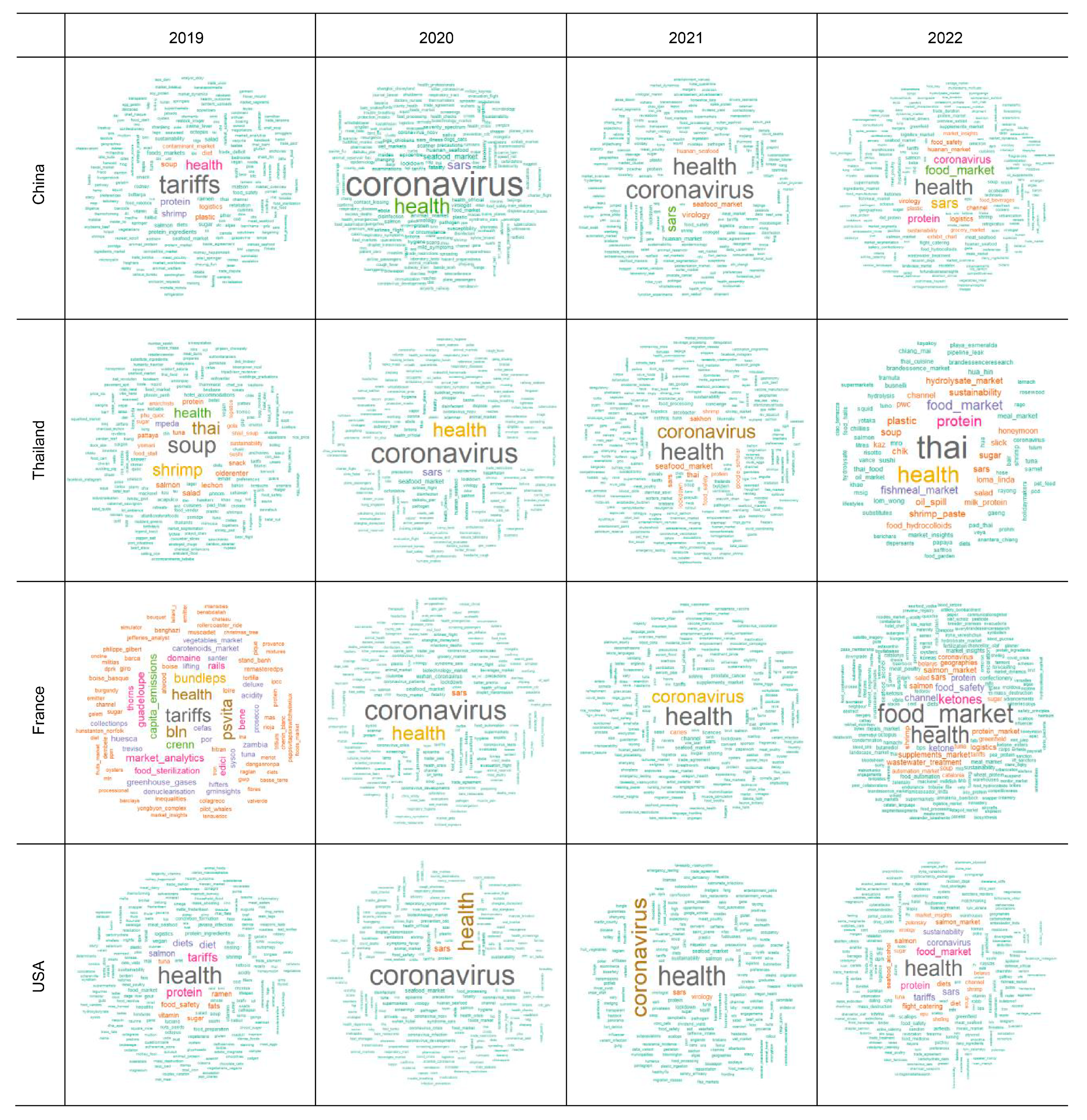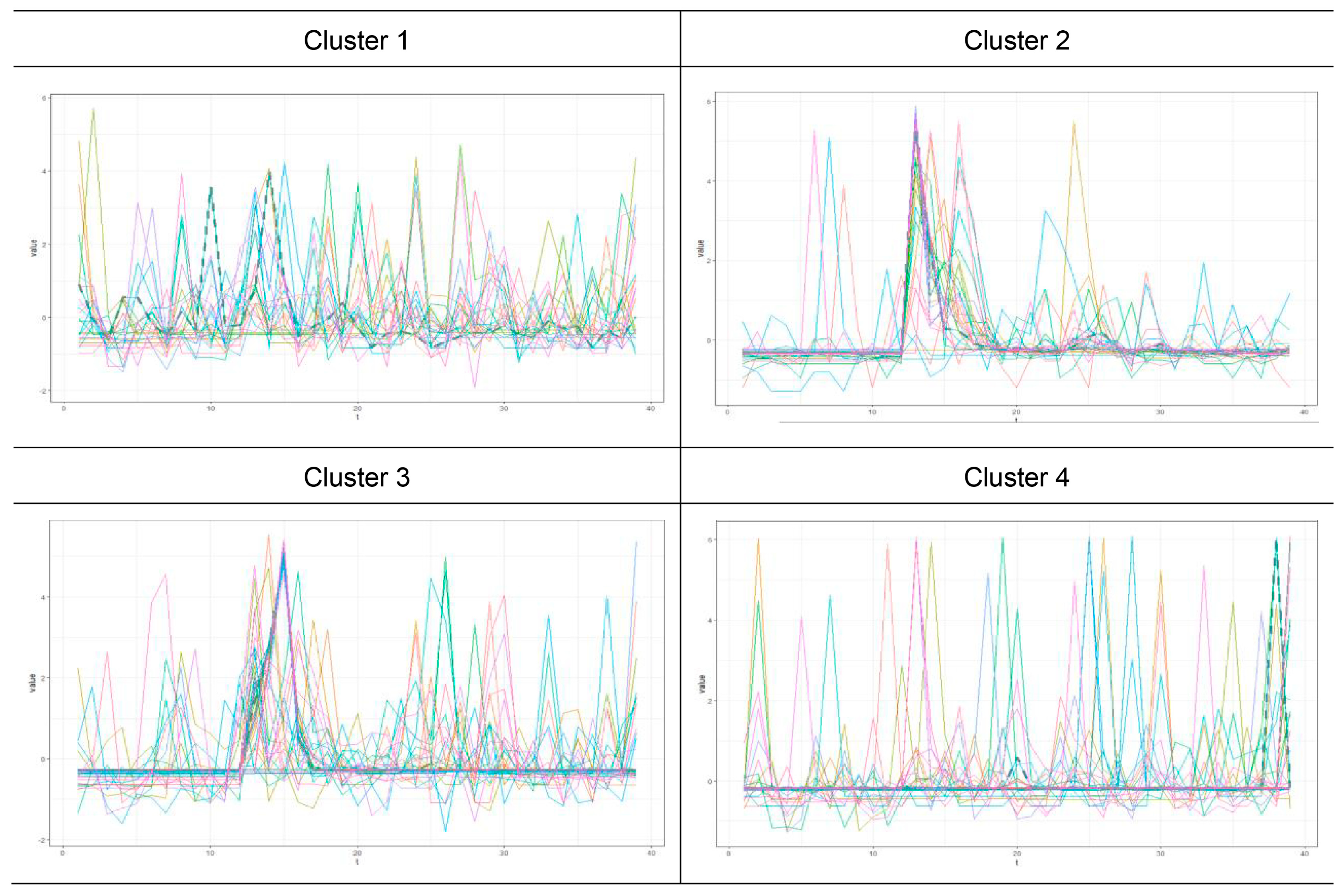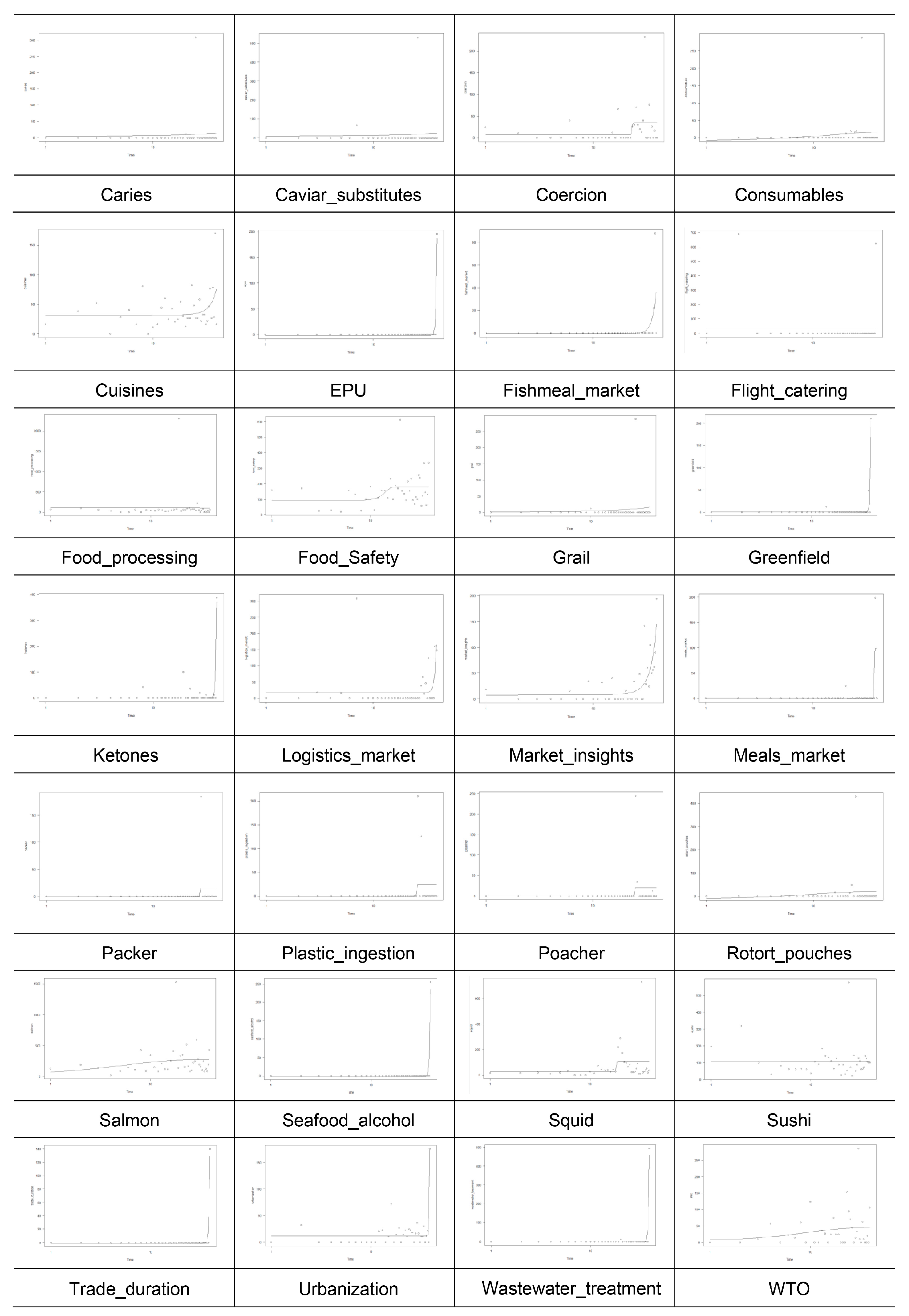Identifying Emerging Issues in the Seafood Industry Based on a Text Mining Approach
Abstract
:1. Introduction
2. Materials and Methods
2.1. Research Framework
2.2. Text Mining (Keyword Analysis)
2.2.1. Data Collection and Preprocessing
2.2.2. Extracting Associated Keywords
2.2.3. Quantifying Dominant Issue Keywords
2.3. Emerging Issues Analysis
2.3.1. Identifying Emergence Patterns of Dominant Issues
2.3.2. Decision on Emerging Issues Candidates
3. Results and Discussion
3.1. Word Cloud
3.1.1. The World
3.1.2. Individual Countries
3.2. Dynamic Time Warping (DTW)
3.3. Growth Model
4. Conclusions
Author Contributions
Funding
Institutional Review Board Statement
Informed Consent Statement
Data Availability Statement
Conflicts of Interest
Abbreviations
Appendix A
| NO | 2019 | 2020 | 2021 | 2022 | ||||
|---|---|---|---|---|---|---|---|---|
| Keywords | Freq. | Keywords | Freq. | Keywords | Freq. | Keywords | Freq. | |
| 1 | tariffs | 1002 | coronavirus | 69,524 | coronavirus | 4994 | health | 1052 |
| 2 | health | 498 | health | 40,238 | health | 4746 | sars | 684 |
| 3 | protein | 312 | sars | 19,020 | sars | 2526 | food_market | 554 |
| 4 | shrimp | 252 | seafood_market | 7586 | virology | 1156 | coronavirus | 490 |
| 5 | soup | 192 | fatality | 3370 | seafood_market | 922 | protein | 460 |
| 6 | plastic | 174 | huanan_seafood | 2620 | huanan_seafood | 644 | logistics | 220 |
| 7 | logistics | 156 | animal_market | 2600 | huanan_market | 584 | huanan_market | 214 |
| 8 | diet | 142 | lockdown | 2508 | protein | 468 | virology | 206 |
| 9 | contaminant_market | 134 | epicenter | 2456 | food_safety | 388 | food_safety | 196 |
| 10 | foods_markets | 122 | virology | 2196 | lockdown | 360 | channel | 182 |
| NO | 2019 | 2020 | 2021 | 2022 | ||||
|---|---|---|---|---|---|---|---|---|
| Keywords | Freq. | Keywords | Freq. | Keywords | Freq. | Keywords | Freq. | |
| 1 | soup | 346 | coronavirus | 35,134 | health | 776 | thai | 178 |
| 2 | thai | 264 | health | 23,184 | coronavirus | 624 | health | 120 |
| 3 | shrimp | 250 | sars | 9532 | seafood_market | 194 | protein | 74 |
| 4 | health | 194 | seafood_market | 3962 | thai | 174 | food_market | 64 |
| 5 | mpeda | 94 | huanan_seafood | 2090 | sars | 150 | fishmeal_market | 46 |
| 6 | salmon | 86 | epicenter | 1380 | sakhon | 134 | plastic | 40 |
| 7 | salad | 84 | lockdown | 1248 | lockdown | 128 | soup | 38 |
| 8 | lechon | 80 | scanner | 1188 | food_safety | 108 | oil_spill | 36 |
| 9 | olderenter | 80 | thai | 1172 | protein | 102 | sustainability | 36 |
| 10 | protein | 74 | airlines_flight | 786 | shrimp | 102 | shrimp_paste | 36 |
| NO | 2019 | 2020 | 2021 | 2022 | ||||
|---|---|---|---|---|---|---|---|---|
| Keywords | Freq. | Keywords | Freq. | Keywords | Freq. | Keywords | Freq. | |
| 1 | tariffs | 56 | coronavirus | 12,098 | foods_market | 422 | food_market | 434 |
| 2 | bln | 48 | health | 8150 | breader_premixes | 392 | health | 384 |
| 3 | psvita | 46 | sars | 2458 | britons | 360 | ketones | 200 |
| 4 | health | 44 | seafood_market | 948 | food_processing | 356 | food_safety | 140 |
| 5 | bundleps | 36 | lockdown | 784 | sars | 150 | channel | 130 |
| 6 | crenn | 32 | wuhan_coronavirus | 762 | sakhon | 134 | ketone | 116 |
| 7 | capita_emissions | 30 | foods_market | 422 | lockdown | 128 | protein | 112 |
| 8 | guadeloupe | 28 | breader_premixes | 392 | food_safety | 108 | salmon_market | 104 |
| 9 | market_analytics | 28 | britons | 360 | protein | 102 | supplements_market | 104 |
| 10 | edici | 24 | food_processing | 356 | shrimp | 102 | sars | 98 |
| NO | 2019 | 2020 | 2021 | 2022 | ||||
|---|---|---|---|---|---|---|---|---|
| Keywords | Freq. | Keywords | Freq. | Keywords | Freq. | Keywords | Freq. | |
| 1 | health | 1044 | coronavirus | 19,696 | health | 2684 | health | 798 |
| 2 | tariffs | 474 | health | 14,776 | coronavirus | 2214 | food_market | 314 |
| 3 | protein | 458 | sars | 4098 | sars | 472 | protein | 306 |
| 4 | diet | 374 | seafood_market | 1890 | virology | 366 | tariffs | 264 |
| 5 | diets | 330 | lockdown | 1138 | salmon | 240 | sars | 264 |
| 6 | salmon | 286 | protein | 746 | seafood_market | 228 | coronavirus | 260 |
| 7 | food_safety | 220 | tariffs | 508 | sustainability | 192 | sustainability | 200 |
| 8 | fats | 218 | epicenter | 442 | protein | 192 | salmon | 182 |
| 9 | ramen | 216 | precautions | 428 | lockdown | 182 | flight_catering | 170 |
| 10 | vitamin | 178 | virology | 422 | zinc | 166 | diets | 168 |
References
- Gersl, A.; Hermanek, J. Indicators of financial system stability: Towards an aggregate financial stability indicator? Prague Econ. Pap. 2008, 2008, 127–142. [Google Scholar] [CrossRef]
- Hines, A.; Baldwin, B.P.; Bengston, D.N.; Crabtree, J.; Christensen, K.; Frankowski, N.; Schlehuber, L.; Westphal, L.M.; Young, L. Monitoring emerging issues: A proposed approach and initial test. World Futures Rev. 2021, 13, 195–213. [Google Scholar] [CrossRef]
- Marsden, G.; Kelly, C.; Snell, C. Selecting indicators for strategic performance management. Transp. Res. Rec. 2006, 1956, 21–29. [Google Scholar] [CrossRef]
- Spangenberg, J.H. Scenarios and Indicators for Sustainable Development: Towards a Critical Assessment of Achievements and Challenges. Sustainability 2019, 11, 942. [Google Scholar] [CrossRef]
- World Development Indicators; The World Bank: Washington, DC, USA, 2023.
- Natale, F.; Borrello, A.; Motova, A. Analysis of the determinants of international seafood trade using a gravity model. Mar. Policy 2015, 60, 98–106. [Google Scholar] [CrossRef]
- Barboza, L.G.A.; Vethaak, A.D.; Lavorante, B.R.B.O.; Lundebye, A.-K.; Guilhermino, L. Marine microplastic debris: An emerging issue for food security, food safety and human health. Mar. Pollut. Bull. 2018, 133, 336–348. [Google Scholar] [CrossRef] [PubMed]
- Miraglia, M.; Marvin, H.J.P.; Kleter, G.A.; Battilani, P.; Brera, C.; Coni, E.; Cubadda, F.; Croci, L.; De Santis, B.; Dekkers, S.; et al. Climate change and food safety: An emerging issue with special focus on Europe. Food Chem. Toxicol. 2009, 47, 1009–1021. [Google Scholar] [CrossRef] [PubMed]
- Food and Agriculture Organization of the United Nations (FAO), Part 4 Emerging issues and outlook. In The State of World Fisheries and Aquaculture; FAO: Rome, Italy, 2022; pp. 195–223.
- Molitor, G.T. How to anticipate public-policy changes. SAM Adv. Manag. J. 1977, 42, 4–13. [Google Scholar]
- Rhemann, M. Understanding disruption through Molitor’s models. World Futures Rev. 2018, 10, 34–37. [Google Scholar] [CrossRef]
- Han, K.; Leem, K.; Choi, Y.R.; Chung, K. What drives a country’s fish consumption? Market growth phase and the causal relations among fish consumption, production and income growth. Fish. Res. 2022, 254, 106435. [Google Scholar]
- Adamuthe, A.C.; Thampi, G.T. Technology forecasting: A case study of computational technologies. Technol. Forecast. Soc. Change 2019, 143, 181–189. [Google Scholar] [CrossRef]
- Kucharavy, D.; De Guio, R. Application of S-shaped curves. Procedia Eng. 2011, 9, 1877–7058. [Google Scholar] [CrossRef]
- Krigsholm, P.; Riekkinen, K. Applying Text Mining for Identifying Future Signals of Land Administration. Land 2019, 8, 181. [Google Scholar] [CrossRef]
- Bai, X.; Zhang, X.; Li, K.X.; Zhou, Y.; Yuen, K.F. Research topics and trends in the maritime transport: A structural topic model. Transp. Policy 2021, 102, 11–24. [Google Scholar] [CrossRef]
- Hase, V.; Mahl, D.; Schäfer, M.S.; Keller, T.R. Climate change in news media across the globe: An automated analysis of issue attention and themes in climate change coverage in 10 countries (2006–2018). Glob. Environ. Change 2021, 70, 102353. [Google Scholar] [CrossRef]
- Velvizhi, V.; Billewar, S.R.; Londhe, G.; Kshirsagar, P.; Kumar, N. Big data for time series and trend analysis of poly waste management in India. Mater. Today Proc. 2021, 37, 2607–2611. [Google Scholar] [CrossRef]
- Kurian, D.; Sattari, F.; Lefsrud, L.; Ma, Y. Using machine learning and keyword analysis to analyze incidents and reduce risk in oil sands operations. Saf. Sci. 2020, 130, 104873. [Google Scholar] [CrossRef]
- Sharma, D.; Kumar, B.; Chand, S. Trend analysis in machine learning research using text mining. In Proceedings of the 2018 International Conference on Advances in Computing, Communication Control and Networking (ICACCCN), Greater Noida, India, 12–13 October 2018; pp. 136–141. [Google Scholar]
- Carbonell, J.; Sánchez-Esguevillas, A.; Carro, B. Assessing emerging issues. The external and internal approach. Futures 2015, 73, 12–21. [Google Scholar] [CrossRef]
- Wang, Q. A bibliometric model for identifying emerging research topics. J. Assoc. Info. Sci. Technol 2018, 69, 290–304. [Google Scholar] [CrossRef]
- Wever, M.; Shah, M.; O’Leary, N. Designing early warning systems for detecting systemic risk: A case study and discussion. Futures 2022, 136, 102882. [Google Scholar] [CrossRef]
- Dator, J. Emerging Issues Analysis: Because of Graham Molitor. World Futures Rev. 2018, 10, 5–10. [Google Scholar] [CrossRef]
- Keogh, E.J.; Pazzani, M.J. Scaling up dynamic time warping to massive datasets. In Principles of Data Mining and Knowledge Discovery; Żytkow, J.M., Rauch, J., Eds.; Springer: Berlin/Heidelberg, Germany, 1999; pp. 1–11. [Google Scholar]
- Müller, M. Dynamic Time Warping. In Information Retrieval for Music and Motion; Springer: Berlin/Heidelberg, Germany, 2007; pp. 69–84. [Google Scholar]
- Arora, P.; Deepali; Varshney, S. Analysis of K-Means and K-Medoids Algorithm For Big Data. Procedia Comput. Sci. 2016, 78, 507–512. [Google Scholar] [CrossRef]
- Rousseeuw, P.J. Sihouettes: A graphical aid to the interpretation and validation of cluster analysis. J. Comput. Appl. Math. 1987, 20, 53–65. [Google Scholar] [CrossRef]
- Saitta, S.; Raphael, B.; Smith, I.F. A Bounded Index for Cluster Validity; Springer: Berlin/Heidelberg, Germany, 2007. [Google Scholar]
- Arbelaitz, O.; Gurrutxaga, I.; Muguerza, J.; Pérez, J.M.; Perona, I. An extensive comparative study of cluster validity indices. Pattern Recognit. 2013, 46, 243–256. [Google Scholar] [CrossRef]
- Kim, M.; Ramakrishna, R.S. New indices for cluster validity assessment. Pattern Recognit. Lett. 2005, 26, 2353–2363. [Google Scholar] [CrossRef]
- Advisors, D.; de Wit, W.; Bigaud, N. No Plastic in Nature: Assessing Plastic Ingestion from Nature to People; World Wildlife Fund for Nature: Gland, Switzerland, 2019. [Google Scholar]






| Country | 2019 | 2020 | 2021 | 2022 | |
|---|---|---|---|---|---|
| East Asia | China | 2795 | 11,255 | 3986 | 697 |
| Japan | 1986 | 4108 | 1605 | 469 | |
| South Korea | 600 | 2815 | 605 | 199 | |
| Southeast Asia | Indonesia | 477 | 737 | 396 | 88 |
| Thailand | 798 | 3132 | 687 | 100 | |
| Vietnam | 800 | 1508 | 651 | 153 | |
| Europe | France | 1600 | 2851 | 1393 | 363 |
| Italy | 1399 | 2440 | 1227 | 298 | |
| Spain | 1176 | 1077 | 854 | 200 | |
| Americas | Canada | 1699 | 2691 | 1495 | 400 |
| USA | 2794 | 4940 | 2648 | 789 | |
| Total | 16,124 | 37,554 | 15,547 | 3756 | |
| [1] | [2] | [3] | [4] | [5] | [6] | [7] | |
|---|---|---|---|---|---|---|---|
| Sil | 0.20 | 0.10 | 0.11 | 0.12 | 0.11 | 0.10 | 0.10 |
| SF | 0.00 | 0.00 | 0.00 | 0.00 | 0.0 | 0.00 | 0.00 |
| CH | 54.12 | 40.35 | 34.09 | 30.09 | 20.66 | 20.78 | 19.31 |
| D | 0.17 | 0.12 | 0.08 | 0.07 | 0.07 | 0.03 | 0.08 |
| DB | 1.59 | 2.19 | 2.09 | 1.41 | 2.12 | 1.49 | 1.58 |
| DBstar | 1.59 | 2.78 | 2.82 | 1.79 | 2.77 | 1.80 | 2.17 |
| COP | 0.50 | 0.46 | 0.44 | 0.42 | 0.41 | 0.40 | 0.38 |
| [1] | [2] | [3] | [4] | [5] | [6] | [7] | |
|---|---|---|---|---|---|---|---|
| Sil | 0.34 | 0.45 | 0.47 | 0.40 | 0.26 | 0.27 | 0.23 |
| SF | 0.00 | 0.00 | 0.00 | 0.00 | 0.00 | 0.00 | 0.00 |
| CH | 96.67 | 84.85 | 76.38 | 64.62 | 48.17 | 35.34 | 39.75 |
| D | 0.03 | 0.04 | 0.08 | 0.09 | 0.00 | 0.06 | 0.05 |
| DB | 1.02 | 0.82 | 0.71 | 1.44 | 1.30 | 1.53 | 1.33 |
| DBstar | 1.02 | 0.98 | 0.91 | 1.80 | 1.93 | 2.12 | 2.13 |
| COP | 0.29 | 0.17 | 0.12 | 0.12 | 0.11 | 0.12 | 0.10 |
| Group Name | Keywords | |||
|---|---|---|---|---|
| Cluster 1 (Periodical Issues) | Cod | Diets | Eco health | Fats |
| Market analytics | Meat market | Meat seafood | Octopus | |
| Oysters | Ramen | Retaliation | Seaweed | |
| Snack | Supermarkets | Sustainability | Swine fever | |
| Tariffs | Tastes | Tuna | Vegan | |
| Warehouses | Wastewater | |||
| Cluster 2 (Corona Issues) | Acidity | Airlines flight | Animal market | Arrivals |
| Beverages_market | Corona | Coronavirus | Disinfectant | |
| Ebola | Eco health | Epicenter | Epidemiology | |
| Evacuees | Gene | Health | Huanan Market | |
| Huanan seafood | Hygiene | Kazakhstan | Meat poultry | |
| Pathogen | Precautions | Prevention CDC | SARS | |
| Scanner | Seafood market | Soup | Thai | |
| Wenliang | Wet markets | |||
| Cluster 3 (Post-Corona Issues) | Automation market | Britons | Ccp | Changing |
| Channel | Circumstance | Contact kissing | Diet | |
| Disinfection | Dogs cats | Escalation | Examinations | |
| Fatality | Ingestion | Insides | Lockdown | |
| Logistics | Market segmentation | Milder | Missteps | |
| Pigs chickens | Plastic | Protein | Protein market | |
| Salad | Saliva | Salmon market | Scans | |
| Severity spectrum | Spillover | Sugar | Syndrome SARS | |
| Taxonomy | Trade agreement | Vibrio Vulnificus | Virologist | |
| Virology | Vitamin | Whcdc | ||
| Cluster 4 (Emerging Issues Candidates) | Caries | Caviar substitutes | Coercion | Consumables |
| Cuisines | EPU | Fishmeal market | Flight catering | |
| Food processing | Food Safety | Grail | Greenfield | |
| Ketones | Logistics market | Market insights | Meals market | |
| Packer | Plastic ingestion | Poacher | Rotort_pouches | |
| Salmon | Seafood alcohol | Squid | Sushi | |
| Trade duration | Urbanization | Wastewater treatment | WTO | |
| Group Name | Keywords | |||
|---|---|---|---|---|
| Cluster 1 (Corona Issues) | Airlines flight | Animal market | Britons | Changing |
| Circumstance | Contact kissing | Corona | Coronavirus | |
| Disinfectant | Disinfection | Dogs cats | Ebola | |
| Epicenter | Evacuees | Examinations | Fatality | |
| Health | Huanan seafood | Hygiene | Insides | |
| Kazakhstan | Lockdown | Milder | Pigs chickens | |
| Prevention CDC | Saliva | SARS | Scanner | |
| Scans | Seafood market | Severity spectrum | Swine fever | |
| Taxonomy | Vibrio Vulnificus | Wenliang | Wet markets | |
| Cluster 2 (Issues of Constant Interest) | Acidity | Arrivals | Ccp | Channel |
| Cuisines | Diet | Diets | Eco health | |
| Epidemiology | EPU | Escalation | Fats | |
| Fishmeal market | Flight catering | Food safety | Food processing | |
| Gene | Huanan market | Ketones | Logistics | |
| Logistics market | Market analytics | Meals market | Meat seafood | |
| Octopus | Oysters | Pathogen | Plastic | |
| Protein | Ramen | Retaliation | Salad | |
| Salmon | Salmon market | Seafood alcohol | Seaweed | |
| Snack | Soup | Squid | Sugar | |
| Supermarkets | Sushi | Sustainability | Tariffs | |
| Tastes | Thai | Trade agreement | Trade duration | |
| Tuna | Urbanization | Vegan | Virologist | |
| Virology | Vitamin | Warehouses | Wastewater treatment | |
| WTO | ||||
| Cluster 3 (Issues of Recent Interest) | Automation market | Beverages_market | Caries | Caviar substitutes |
| Coercion | Consumables | Food market | Geographies | |
| Grail | Greenfield | Ingestion | Market breakup | |
| Market insights | Market segmentation | Meat market | Meat poultry | |
| Missteps | Packer | Plastic ingestion | Poacher | |
| Protein market | Retort_pouches | Spillover | Wastewater | |
| Whcdc | ||||
Disclaimer/Publisher’s Note: The statements, opinions and data contained in all publications are solely those of the individual author(s) and contributor(s) and not of MDPI and/or the editor(s). MDPI and/or the editor(s) disclaim responsibility for any injury to people or property resulting from any ideas, methods, instructions or products referred to in the content. |
© 2024 by the authors. Licensee MDPI, Basel, Switzerland. This article is an open access article distributed under the terms and conditions of the Creative Commons Attribution (CC BY) license (https://creativecommons.org/licenses/by/4.0/).
Share and Cite
Han, K.; Yeom, J.; Chung, K. Identifying Emerging Issues in the Seafood Industry Based on a Text Mining Approach. Appl. Sci. 2024, 14, 1820. https://doi.org/10.3390/app14051820
Han K, Yeom J, Chung K. Identifying Emerging Issues in the Seafood Industry Based on a Text Mining Approach. Applied Sciences. 2024; 14(5):1820. https://doi.org/10.3390/app14051820
Chicago/Turabian StyleHan, Kiuk, Jaesun Yeom, and Keunsuk Chung. 2024. "Identifying Emerging Issues in the Seafood Industry Based on a Text Mining Approach" Applied Sciences 14, no. 5: 1820. https://doi.org/10.3390/app14051820







